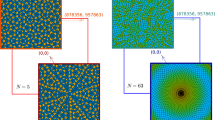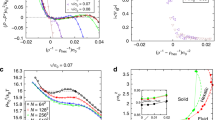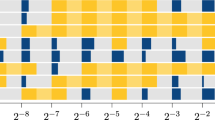Abstract
BICONTINUOUS partitioning of a volume is produced by inscribing a continuous, orientable surface of positive genus without self-intersection. This divides the volume into two multiply connected, interpenetrating subvolumes, each of them physically continuous (mathematically connected). Neither on a line nor in the plane is there an analogue. A bicontinuous structure is a bicontinuous partitioning in which each subvolume is filled with a distinct, not necessarily uniform composition or state of matter. In familiar examples one subvolume is solid or semi-solid, for example sandstone or sponge. An interspersion of two phases is bicontinuous only if each phase is connected across the specimen.
This is a preview of subscription content, access via your institution
Access options
Subscribe to this journal
Receive 51 print issues and online access
$199.00 per year
only $3.90 per issue
Buy this article
- Purchase on Springer Link
- Instant access to full article PDF
Prices may be subject to local taxes which are calculated during checkout
Similar content being viewed by others
References
Winsor, P. A., Trans. Faraday Soc., 44, 376, 382, 387, 390 (1948); Solvent Properties of Amphiphilic Compounds (Butterworths, London, 1954).
Winsor, P. A., Chem. Rev., 68, 1 (1968).
Ekwall, P., Mandell, L., and Fontell, L., Proc. Fifth Int. Congr. on Surface Active Substances (Barcelona), 2, 443 (1968).
Shinoda, K., and Friberg, S., Adv. Colloid Interface Sci., 4, 281 (1975).
Healy, R. N., Reed, R. L., and Stenmark, D. G., Soc. Petrol Engrs, Paper No. 5565 (presented at Dallas, Texas, 28 Sept. 1975); Soc. Petrol. Eng. J., 16 (in the press).
Schwarz, H. A., Gesamm. math. Abh. (Springer, Berlin, 1980).
Nitsche, J. C. C., Vorlesungen über Minimalflächen, Sections 276–281, 818, 882 (Springer, Berlin, 1975).
Schoen, A. H. NASA TN D-5541 (Washington, DC, 1970).
Neovius, E. R., Bestimmung zweier speziellen periodischen Minimalflächen (J. C. Frenkel, Helsingfors, 1883).
Murphy, C. L. thesis, University of Minnesota (1966).
Proc. Symp. Micellization, Solubilization and Microemulsions, Am. chem. Soc., New York, 1976 (edit. by Mittal, K. L.) (Plenum, New York, in the press).
Author information
Authors and Affiliations
Rights and permissions
About this article
Cite this article
SCRIVEN, L. Equilibrium bicontinuous structure. Nature 263, 123–125 (1976). https://doi.org/10.1038/263123a0
Received:
Accepted:
Issue Date:
DOI: https://doi.org/10.1038/263123a0
This article is cited by
-
Microinterfaces in biopolymer-based bicontinuous hydrogels guide rapid 3D cell migration
Nature Communications (2024)
-
A Novel Metastable Structure in Polycrystalline Metals With Extremely Fine Grains: Schwarz Crystal
Metallurgical and Materials Transactions A (2024)
-
Medial packing and elastic asymmetry stabilize the double-gyroid in block copolymers
Nature Communications (2022)
-
Bicontinuous cubic phases in biological and artificial self-assembled systems
Science China Materials (2020)
-
Design and Simulation of Flow Field for Bone Tissue Engineering Scaffold Based on Triply Periodic Minimal Surface
Chinese Journal of Mechanical Engineering (2019)
Comments
By submitting a comment you agree to abide by our Terms and Community Guidelines. If you find something abusive or that does not comply with our terms or guidelines please flag it as inappropriate.



